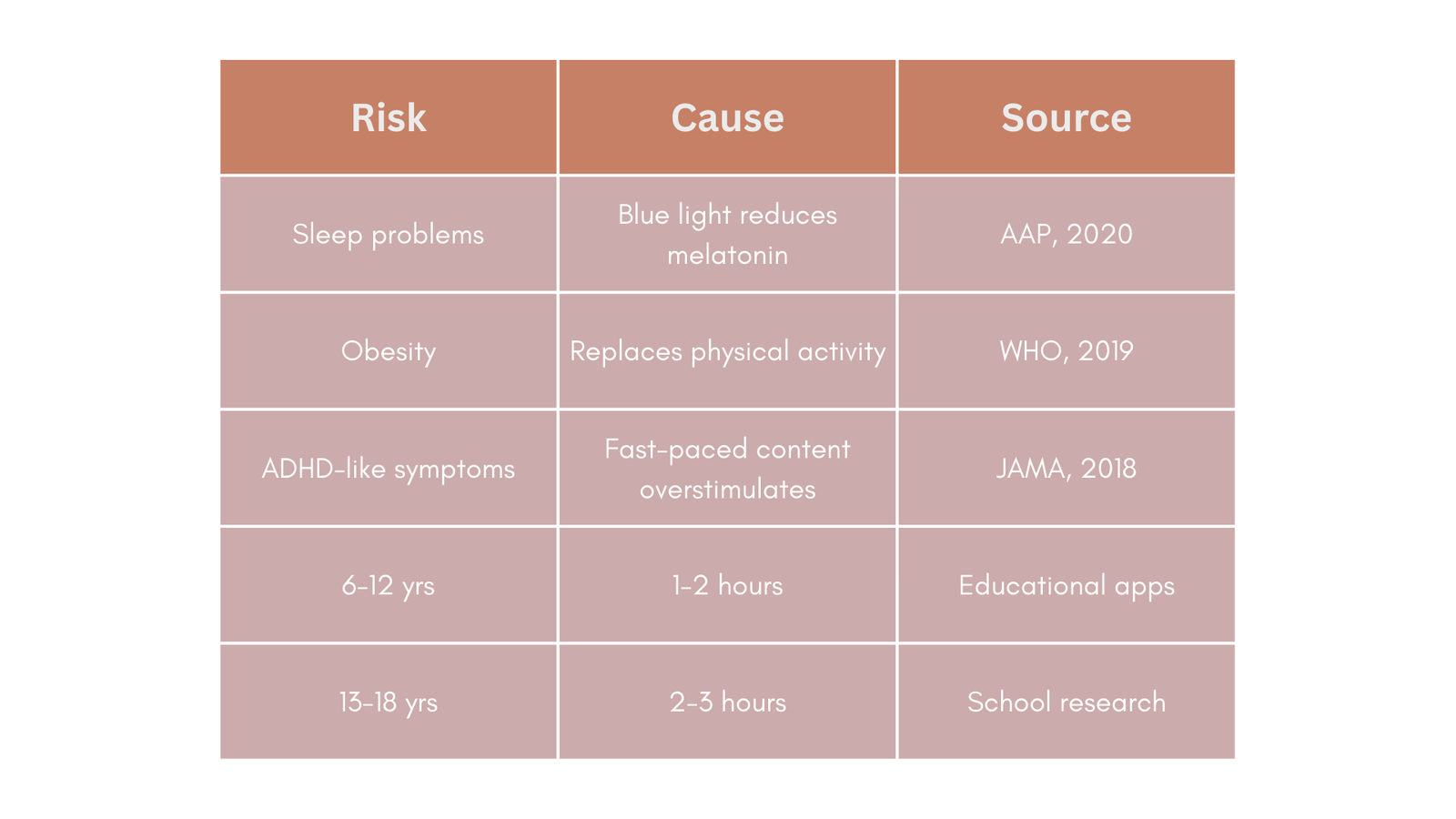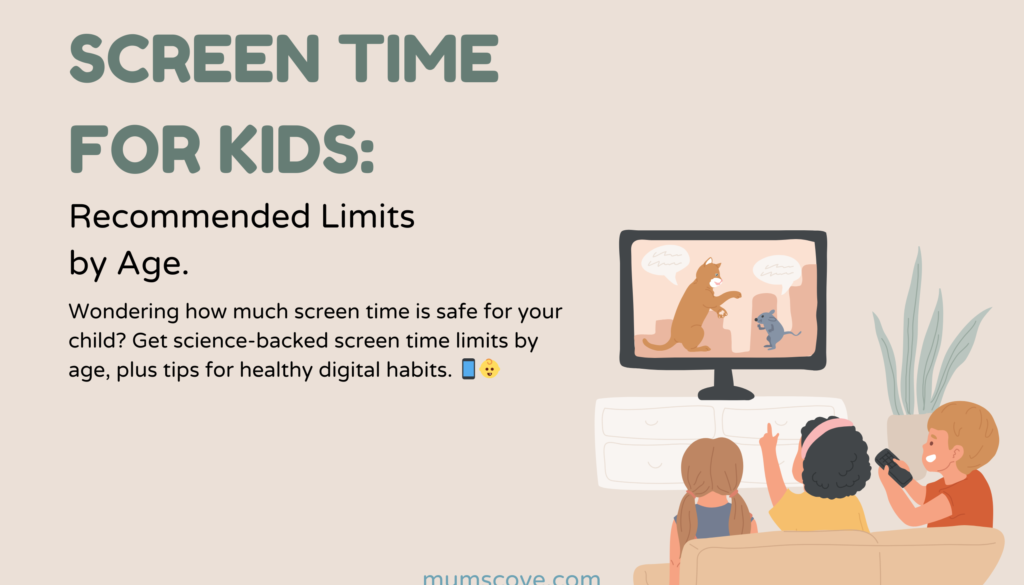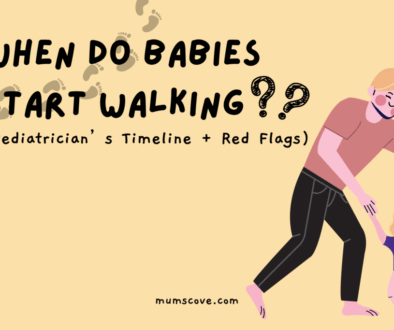Screen Time Limits by Age: Science-Backed Guidelines for Kids (2025)
📱 Introduction: Why Screen Time Rules Matter
Screens are everywhere—from tablets in schools to smartphones at dinner tables. But excessive screen time is linked to:
-
🚨 Sleep disruption (blue light suppresses melatonin)
-
🚨 Behavioral issues (per JAMA Pediatrics)
-
🚨 Delayed social skills in toddlers
This guide covers science-backed screen time limits by age, approved by the American Academy of Pediatrics (AAP) and World Health Organization (WHO).
Key Questions Answered:
✔ How much screen time is OK for a 3-year-old?
✔ Does homework count toward screen time?
✔ What are healthy alternatives to screens?
👶 Screen Time Guidelines by Age (0–18 Years)
1. Babies (0–18 Months): Avoid Screens
AAP Recommendation: Zero screen time (except video calls with family).
Why?
-
Infants learn best through face-to-face interaction (Pediatrics, 2018).
-
Screen exposure may delay language development.
Pro Tip: Use audio-only lullabies instead of videos.
2. Toddlers (18–24 Months): 30 Minutes Max
Best Content:
-
Educational programs with slow pacing (Sesame Street, Ms. Rachel).
-
Avoid: Fast-cut cartoons (e.g., Cocomelon) – linked to hyperactivity (University of Alberta, 2022).
Must-Do:
▶️ Co-watch and narrate: “Look, Elmo is sharing his toy! Do you share your toys too?”
3. Preschoolers (2–5 Years): 1 Hour/Day
Content Type: High-quality educational programs (e.g., Sesame Street).
Must-Do: Co-watch and discuss what they see.
Top-Rated Apps:
✅ Khan Academy Kids (ad-free, curriculum-based)
✅ PBS Kids Games (STEM-focused)
Red Flags:
❌ Autoplay on YouTube Kids (leads to binge-watching)
❌ Violent content (even “mild” cartoons increase aggression per AAP).
Homework Exception:
▶️ Offline alternatives: Use physical flashcards instead of math apps when possible.
4. School-Age Kids (6–12 Years): 1–2 Hours/Day
Rules That Work:
-
Tech-Free Zones: No devices at meals or in bedrooms.
-
Homework Policy: Educational screen time doesn’t count toward limits.
Danger Zone:
⚠️ Roblox/Minecraft before age 8 (risk of addictive design – Common Sense Media).
Pro Tip:
▶️ Use Google Family Link to auto-lock apps after 2 hours.
5. Teens (13–18 Years): 2–3 Hours/Day
Critical Boundaries:
-
No screens 1 hour before bed (blue light disrupts sleep cycles).
-
Social Media Curfew: Disable notifications after 9 PM.
Stats That Shock Parents:
-
Teens who exceed 3 hours/day are 34% more likely to develop anxiety (CDC, 2023).
Homework Hack:
▶️ Laptop for schoolwork + grayscale mode on phones (reduces distraction).
⚠️ Effects of Screen Time on Children
Science-Backed Risks:

Expert Quote:
“For kids under 2, screens offer no proven benefits—only risks. Prioritize real-world play.”
— Dr. Sarah Adams, Pediatrician
💡 5 Actionable Tips to Reduce Screen Time
-
Set a Family Media Plan
-
Use AAP’s free Family Media Plan Tool.
-
-
Tech-Free Zones
-
Ban devices at meals + bedrooms.
-
-
Swap Screens for Play
-
Example: “After 30 mins of TV, build a fort together!”
-
-
Use Parental Controls
-
Apple Screen Time or Google Family Link tutorials.
-
-
Model Healthy Habits
-
Kids mimic parents—put your phone away!
-
📢 Key Takeaways (H2 for snippet)
✔ Under 2? Avoid screens (except video calls).
✔ Ages 2–5? 1 hour/day max of educational content.
✔ Teens? 2–3 hours/day (excluding homework).
✔ Use parental controls to automate limits.
📥 Free Download:
Screen Time Rules Cheat Sheet
✨ What’s Inside:
-
AAP-Approved Limits by Age (0–18 years)
-
Healthy Alternatives to Screens (50+ activity ideas)



